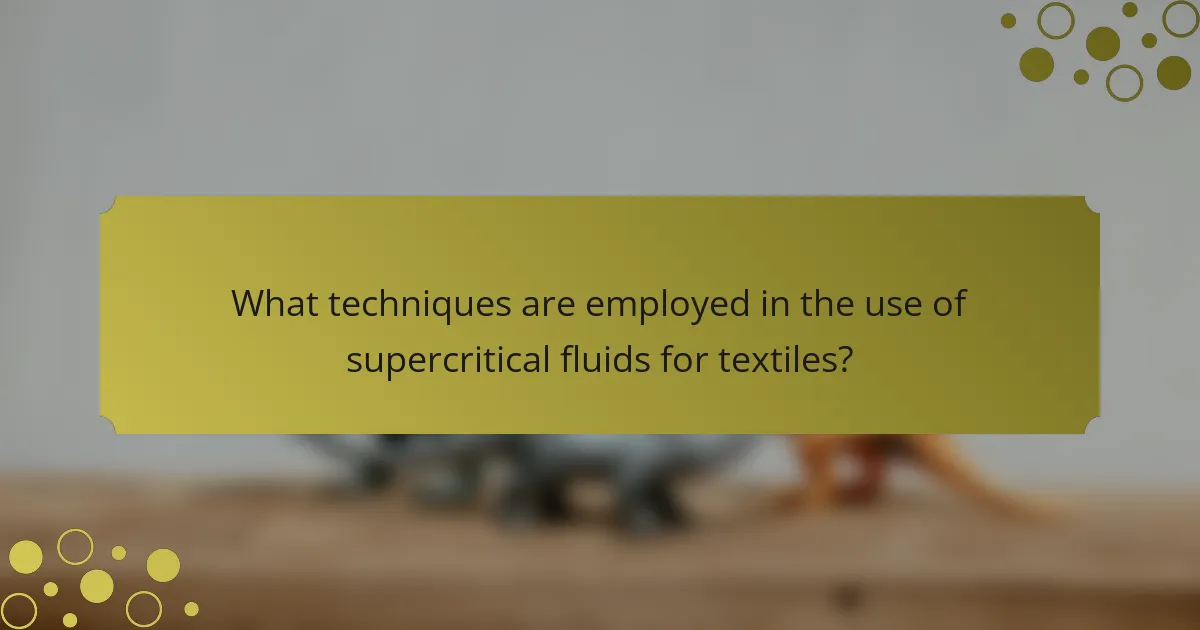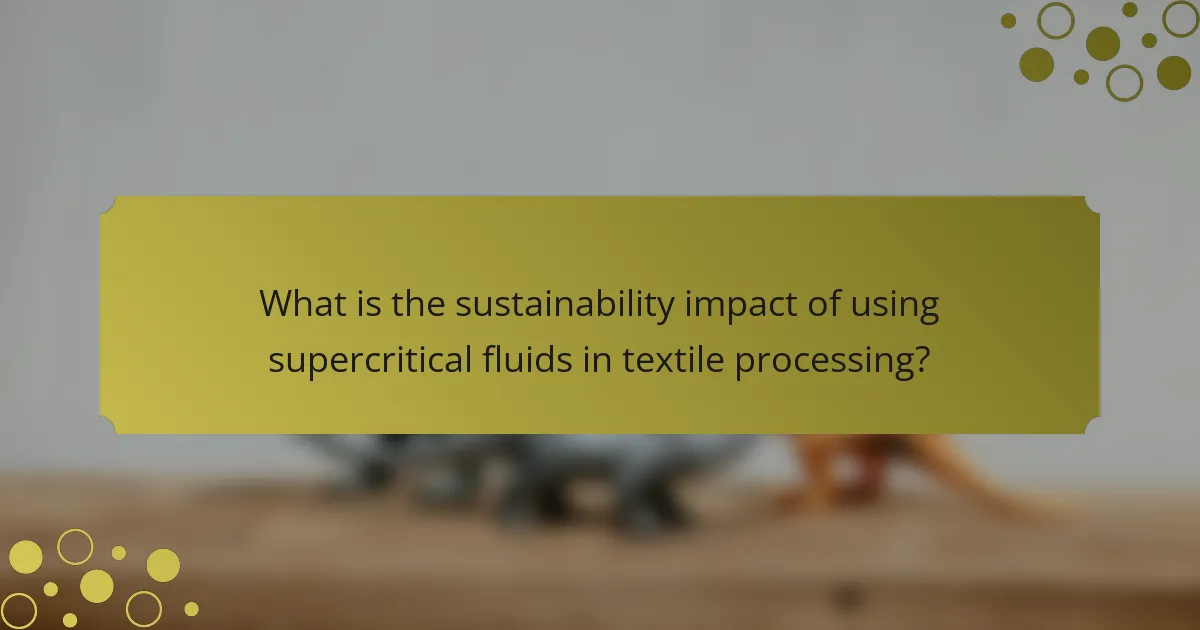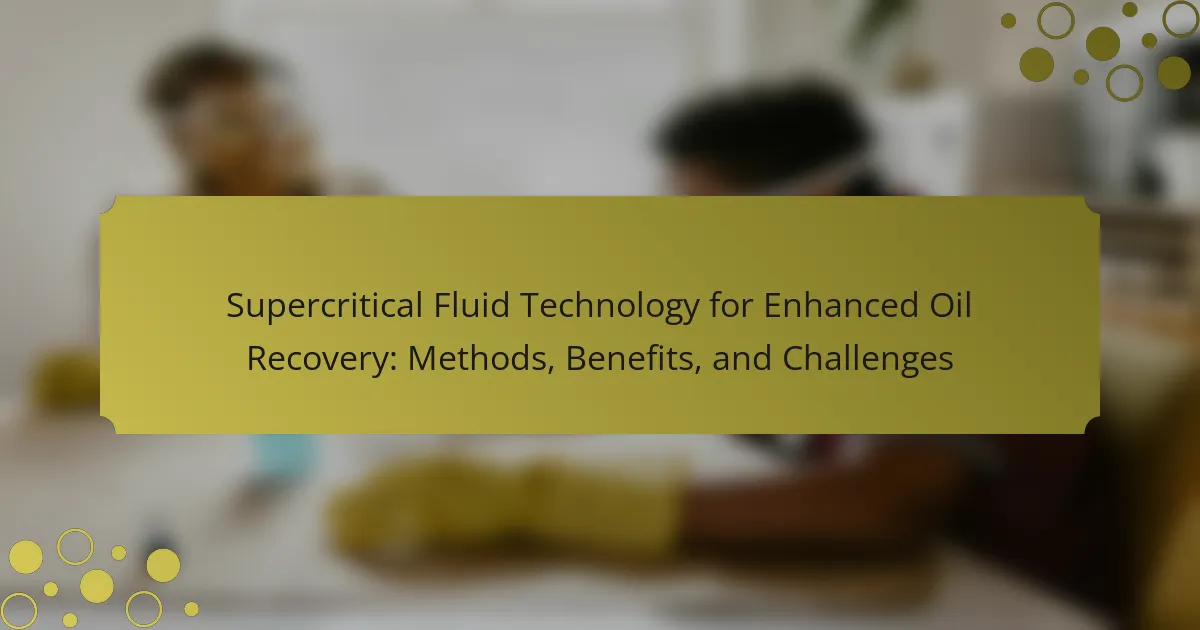Supercritical fluids, particularly supercritical carbon dioxide (CO2), are substances that exist above their critical temperature and pressure, displaying characteristics of both liquids and gases. In textile processing, these fluids are utilized for dyeing, cleaning, and extracting natural dyes and oils from plant materials, offering benefits such as reduced water consumption and the elimination of harmful solvents. The use of supercritical CO2 significantly decreases the environmental impact of textile processing by minimizing volatile organic compound emissions and enhancing dye uptake efficiency. Overall, supercritical fluid techniques promote sustainable practices in the textile industry while maintaining high-quality color application and fabric integrity.

What are Supercritical Fluids and Their Role in Textile Processing?
Supercritical fluids are substances at a temperature and pressure above their critical point, exhibiting properties of both liquids and gases. In textile processing, they are used primarily for dyeing and cleaning fabrics. Their unique solvation properties allow for efficient [censured] of fibers. Supercritical carbon dioxide (CO2) is the most commonly used supercritical fluid in this context. It is non-toxic, environmentally friendly, and can effectively dissolve various dyes. This method reduces water consumption and eliminates harmful solvents. Studies show that supercritical CO2 dyeing can achieve high-quality color application with minimal environmental impact.
How do supercritical fluids differ from traditional solvents?
Supercritical fluids differ from traditional solvents primarily in their unique phase behavior. Supercritical fluids exist above their critical temperature and pressure, combining properties of both liquids and gases. This allows them to dissolve materials more effectively than traditional solvents. Additionally, supercritical fluids have lower viscosities, enhancing mass transfer during processes. Their tunable density and solubility can be adjusted by altering temperature and pressure. Traditional solvents, in contrast, have fixed properties and cannot achieve the same versatility. Studies have shown that supercritical carbon dioxide can replace harmful organic solvents in various applications, making it an eco-friendly alternative.
What are the key properties of supercritical fluids that make them suitable for textile processing?
Supercritical fluids possess unique properties that make them suitable for textile processing. They have low viscosity, allowing for better [censured] into fibers. Their high diffusivity enhances the ability to extract or dissolve substances effectively. Supercritical fluids can act as solvents without leaving harmful residues. They are tunable in terms of density and solvation power by adjusting temperature and pressure. This flexibility enables targeted processing of various textiles. Additionally, supercritical fluids are environmentally friendly, reducing the need for toxic solvents. Research indicates that using supercritical carbon dioxide can significantly improve dye uptake in textiles. These properties collectively enhance efficiency and sustainability in textile processing.
How does the critical point of a fluid influence its application in textiles?
The critical point of a fluid determines its phase behavior and properties during textile processing. At the critical point, distinct liquid and gas phases merge, creating a supercritical fluid. Supercritical fluids exhibit unique solvation properties, allowing them to penetrate textiles effectively. This enhances dyeing, cleaning, and extraction processes in textile applications. For example, supercritical carbon dioxide is used for dyeing fabrics without water, reducing environmental impact. Studies show that using supercritical fluids can improve dye uptake by up to 30%. This efficiency leads to reduced processing times and energy consumption in textile manufacturing.
What advantages do supercritical fluids offer in textile processing?
Supercritical fluids offer several advantages in textile processing. They are effective solvents, allowing for efficient dyeing and finishing of fabrics. Supercritical CO2, for example, can dissolve dyes and chemicals without the need for harmful organic solvents. This reduces environmental impact and improves safety in textile manufacturing. Additionally, supercritical fluids can penetrate fabrics easily, ensuring uniform treatment. Their low viscosity enhances the transport of substances within textiles. Furthermore, the process often requires lower temperatures, preserving the integrity of sensitive materials. Overall, supercritical fluids enhance efficiency, sustainability, and safety in textile processing.
How do supercritical fluids enhance dyeing and finishing processes?
Supercritical fluids enhance dyeing and finishing processes by providing efficient solvation and [censured] into textile materials. They facilitate the transport of dyes and finishing agents into fibers, leading to improved color uniformity and depth. The use of supercritical carbon dioxide, for example, allows for lower processing temperatures and reduced water usage. This method minimizes environmental impact compared to traditional dyeing techniques. Research indicates that supercritical fluids can achieve dye uptake rates that are significantly higher than conventional methods. Additionally, they can reduce the need for auxiliary chemicals, further promoting sustainability in textile processing.
What environmental benefits are associated with using supercritical fluids in textiles?
Supercritical fluids in textiles provide significant environmental benefits. They reduce the use of harmful solvents, minimizing toxic waste. This method also decreases water consumption compared to traditional processes. Supercritical CO2, for instance, can clean and dye fabrics without harmful chemicals. The energy required for supercritical fluid processes is often lower than conventional methods. This leads to a smaller carbon footprint in textile production. Additionally, supercritical fluids can be recycled and reused, promoting sustainability. Overall, these advantages contribute to a more eco-friendly textile industry.

What techniques are employed in the use of supercritical fluids for textiles?
Supercritical fluid techniques employed in textiles include extraction, dyeing, and cleaning. Supercritical CO2 is commonly used for extracting natural dyes and oils from plant materials. This method is efficient, reducing solvent waste and energy consumption. For dyeing, supercritical fluids allow for uniform color application without water. This process minimizes environmental impact and enhances colorfastness. Cleaning techniques utilize supercritical fluids to remove contaminants from fabrics. This method is effective in maintaining fabric integrity while being eco-friendly. Overall, these techniques leverage the unique properties of supercritical fluids to improve textile processing.
What are the common methods of applying supercritical fluids in textile processing?
Common methods of applying supercritical fluids in textile processing include dyeing, cleaning, and finishing. Supercritical carbon dioxide is frequently used for dyeing textiles. This method allows for even dye distribution and reduced water usage. Cleaning processes utilize supercritical fluids to remove contaminants without harsh chemicals. Additionally, supercritical fluids can enhance the finishing of fabrics by improving their properties. These methods are gaining popularity due to their eco-friendliness and efficiency.
How does supercritical CO2 extraction work in textile applications?
Supercritical CO2 extraction in textile applications utilizes supercritical carbon dioxide as a solvent to extract specific compounds from materials. In this process, CO2 is heated and pressurized beyond its critical point, becoming supercritical. This state allows CO2 to exhibit properties of both a gas and a liquid, enhancing its ability to dissolve various substances.
During extraction, supercritical CO2 penetrates the textile fibers, effectively dissolving oils, dyes, and contaminants. The process is efficient and environmentally friendly, as CO2 is non-toxic and leaves no harmful residues.
Studies show that supercritical CO2 extraction can enhance the quality of textiles by improving colorfastness and reducing the need for chemical additives. Additionally, it allows for the recovery of valuable compounds, making it a sustainable option in textile processing.
What role does pressure play in the effectiveness of supercritical fluid techniques?
Pressure is crucial in supercritical fluid techniques as it influences the solubility and density of the supercritical fluid. Higher pressure increases the density of the fluid, enhancing its solvent power. This allows for better extraction of substances from textiles, improving efficiency. For example, carbon dioxide, commonly used as a supercritical fluid, becomes a more effective solvent at elevated pressures. Studies show that optimal pressure settings can significantly enhance the extraction yield. Thus, pressure directly impacts the effectiveness of supercritical fluid techniques in textile processing.
How can supercritical fluids be integrated into existing textile manufacturing processes?
Supercritical fluids can be integrated into existing textile manufacturing processes through various techniques. These fluids can replace traditional solvents in dyeing and finishing processes. This integration enhances the efficiency of dye uptake and reduces water usage. Supercritical CO2 is commonly used due to its ability to dissolve dyes without the need for water.
Additionally, supercritical fluids can aid in the extraction of natural dyes and chemicals from plant materials. This method promotes sustainability by minimizing harmful waste. Research indicates that using supercritical fluids can lead to improved colorfastness in textiles. The transition to supercritical fluid technology can also lower energy consumption in textile production.
Overall, the adoption of supercritical fluids in textile manufacturing aligns with environmental goals and operational efficiency.
What modifications are necessary for existing equipment to accommodate supercritical fluid processing?
Existing equipment requires several modifications to accommodate supercritical fluid processing. First, pressure vessels must be upgraded to withstand higher pressures, typically around 1000 to 5000 psi. Second, temperature controls need enhancement to maintain the necessary temperatures, often exceeding 31°C for carbon dioxide. Third, seals and gaskets must be compatible with supercritical fluids to prevent leaks. Additionally, piping systems should be modified to handle the unique flow characteristics of supercritical fluids. Finally, safety systems must be improved to manage the risks associated with high-pressure operations. These modifications ensure efficient and safe processing of textiles using supercritical fluids.
How do manufacturers ensure safety when using supercritical fluids?
Manufacturers ensure safety when using supercritical fluids through strict adherence to safety protocols and regulations. They conduct comprehensive risk assessments to identify potential hazards associated with supercritical fluid use. Manufacturers implement engineering controls, such as pressure relief systems and robust containment measures, to prevent leaks and accidents. They also provide extensive training for personnel on handling supercritical fluids safely. Additionally, regular maintenance and inspection of equipment are crucial to ensure operational integrity. Safety data sheets (SDS) are made available to inform staff about the properties and hazards of the fluids used. Moreover, manufacturers comply with industry standards and guidelines, which often include safety certifications. These measures collectively enhance the safety of processes involving supercritical fluids in textile processing.

What is the sustainability impact of using supercritical fluids in textile processing?
The sustainability impact of using supercritical fluids in textile processing is significant. Supercritical fluids reduce the need for harmful solvents in the dyeing and finishing processes. This leads to lower emissions of volatile organic compounds (VOCs). The use of supercritical carbon dioxide, for example, minimizes water consumption. Traditional textile processing can use up to 100 liters of water per kilogram of fabric. In contrast, supercritical fluid processes can use less than 10 liters. Additionally, supercritical fluids can enhance the efficiency of dye uptake, reducing waste. Studies show that these methods can produce textiles with a lower environmental footprint. Overall, supercritical fluids contribute to more sustainable practices in the textile industry.
How do supercritical fluids contribute to sustainable textile production?
Supercritical fluids contribute to sustainable textile production by providing an eco-friendly alternative to traditional solvents. They enable efficient dyeing and finishing processes without the use of harmful chemicals. Supercritical carbon dioxide, for example, is non-toxic and can be recycled easily. This method reduces water consumption significantly, with some processes using up to 90% less water than conventional methods. Additionally, supercritical fluids can extract natural dyes from plants, promoting the use of renewable resources. Studies show that using supercritical fluids can lower energy consumption during processing. These factors collectively enhance sustainability in the textile industry by minimizing environmental impact.
What are the lifecycle benefits of textiles processed with supercritical fluids?
Textiles processed with supercritical fluids offer significant lifecycle benefits. These benefits include reduced environmental impact and enhanced material properties. Supercritical fluid processing uses less water and energy compared to traditional methods. This leads to lower carbon emissions during production. Additionally, the process eliminates the need for harmful solvents. This results in safer working conditions for manufacturers. The textiles produced are often more durable and have improved performance characteristics. Studies show that supercritical CO2 can effectively remove contaminants from fabrics without damaging them.
How does the use of supercritical fluids reduce waste in textile manufacturing?
The use of supercritical fluids reduces waste in textile manufacturing by enabling efficient dyeing and finishing processes. Supercritical fluids, such as carbon dioxide, act as solvents without the need for large amounts of water or harmful chemicals. This significantly minimizes the environmental impact associated with traditional methods.
By using supercritical fluids, manufacturers can achieve better dye uptake and uniformity. This leads to reduced dye wastage and lower chemical discharge into wastewater systems. Studies have shown that supercritical CO2 can dissolve dyes effectively, allowing for precise application and less excess material.
Additionally, the use of supercritical fluids can facilitate the extraction of residual chemicals from textiles, further decreasing waste. Overall, this innovative approach not only improves efficiency but also supports sustainable practices in the textile industry.
What challenges exist in the adoption of supercritical fluids in the textile industry?
The challenges in adopting supercritical fluids in the textile industry include high operational costs and technical complexity. The initial investment for supercritical fluid equipment is significant. This includes costs for high-pressure vessels and specialized machinery. Additionally, the technical expertise required to operate these systems is often lacking. Many textile manufacturers may not have staff trained in supercritical fluid technology. There are also limitations regarding the types of textiles that can be treated effectively. Some fabrics may not respond well to supercritical fluid processes. Furthermore, regulatory challenges may arise concerning safety and environmental compliance. These factors collectively hinder widespread adoption in the textile sector.
What are the economic considerations for manufacturers when transitioning to supercritical fluid technologies?
Manufacturers face several economic considerations when transitioning to supercritical fluid technologies. Initial investment costs are significant, including equipment and technology upgrades. Operating costs can vary based on the scale of production and the specific supercritical fluid used. Energy efficiency is a critical factor, as supercritical processes often require less energy compared to traditional methods. However, the cost of supercritical fluids themselves can impact overall expenses.
Return on investment (ROI) is another key consideration. The potential for reduced waste and improved product quality can lead to long-term savings. Manufacturers must also consider regulatory compliance costs associated with new technologies. Market demand for sustainable practices can influence the economic viability of the transition. Lastly, training and workforce development costs should be factored into the overall economic assessment.
How can these challenges be overcome to promote wider adoption?
To overcome challenges in the adoption of supercritical fluids in textile processing, education and awareness are essential. Training programs can inform stakeholders about the benefits and techniques of supercritical fluid technology. Industry partnerships can facilitate knowledge sharing and resources. Financial incentives can encourage investment in new technologies. Research funding can support innovation and address technical barriers. Demonstration projects can showcase successful applications and build confidence. Regulatory support can create a favorable environment for adoption. Collectively, these strategies can promote wider acceptance and use of supercritical fluids in the textile industry.
What best practices should be followed when using supercritical fluids in textile processing?
Best practices for using supercritical fluids in textile processing include maintaining optimal temperature and pressure parameters. These conditions enhance solubility and extraction efficiency. Regular calibration of equipment ensures consistent performance and quality. Implementing safety protocols is crucial due to the high pressures involved. Using high-purity solvents minimizes contamination and improves product quality. Conducting pre-treatment of textiles can enhance the effectiveness of supercritical fluid processes. Continuous monitoring of processes allows for real-time adjustments, ensuring optimal results. Finally, thorough training for operators on equipment and safety measures is essential for successful implementation.
How can manufacturers optimize their processes for maximum efficiency with supercritical fluids?
Manufacturers can optimize their processes with supercritical fluids by adjusting temperature and pressure conditions. Fine-tuning these parameters enhances solubility and extraction efficiency. Implementing continuous flow systems improves reaction times and reduces processing times. Using advanced monitoring technologies allows for real-time adjustments to maintain optimal conditions. Training personnel on supercritical fluid technology ensures better operational practices. Regular maintenance of equipment minimizes downtime and maximizes throughput. Integrating supercritical fluid processes with existing systems can improve overall efficiency. Studies show that optimized supercritical fluid processes can reduce solvent usage by up to 90%, enhancing sustainability.
What safety protocols should be implemented during the use of supercritical fluids in textiles?
Implementing safety protocols during the use of supercritical fluids in textiles is crucial. First, ensure proper ventilation in work areas to prevent gas accumulation. Second, use appropriate personal protective equipment (PPE) such as gloves and goggles. Third, conduct regular equipment maintenance to avoid leaks and malfunctions. Fourth, implement pressure relief systems to manage potential over-pressurization. Fifth, train personnel on emergency procedures and the properties of supercritical fluids. Sixth, establish clear labeling and storage guidelines for hazardous materials. These protocols help mitigate risks associated with supercritical fluid usage in textile processing.
The main entity of this article is supercritical fluids, specifically their application in textile processing. The article outlines the unique properties of supercritical fluids, such as their ability to function as effective solvents while minimizing environmental impact. Key topics include the advantages of using supercritical carbon dioxide for dyeing and cleaning textiles, the techniques employed in these processes, and the sustainability benefits associated with reducing water usage and harmful solvents. Additionally, the article addresses the challenges and economic considerations manufacturers face when adopting supercritical fluid technologies in textile production. Overall, it emphasizes the role of supercritical fluids in enhancing efficiency and promoting eco-friendly practices in the textile industry.



